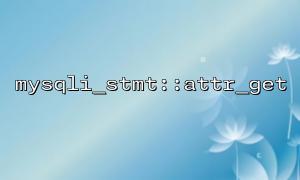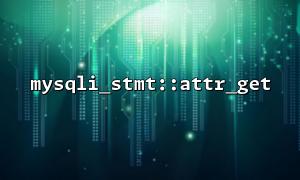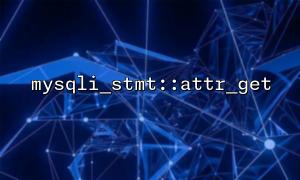When using the mysqli extension in PHP for database operations, developers typically encounter a series of methods provided by the mysqli_stmt class. These methods are designed to work with prepared statements to improve performance and enhance security. The mysqli_stmt::attr_get function, introduced in PHP 8.1, allows developers to access certain low-level attributes of prepared statements. However, the introduction of this new feature has inevitably raised concerns about its security. This article will discuss whether the mysqli_stmt::attr_get function presents any security risks and summarize the potential issues when using it.
mysqli_stmt::attr_get is a function used to retrieve the attributes of a mysqli_stmt object. Its prototype is as follows:
public mysqli_stmt::attr_get(int $attribute): int|false
It allows developers to read certain internal statement attributes, such as MYSQLI_STMT_ATTR_UPDATE_MAX_LENGTH. In specific scenarios, this can help optimize program logic, for example, by pre-allocating memory.
Here’s an example code:
$mysqli = new mysqli("localhost", "user", "password", "database");
<p>$stmt = $mysqli->prepare("SELECT * FROM users WHERE status = ?");<br>
$stmt->bind_param("s", $status);<br>
$stmt->attr_set(MYSQLI_STMT_ATTR_UPDATE_MAX_LENGTH, true);<br>
$stmt->execute();<br>
$stmt->store_result();</p>
<p>$maxLenAttr = $stmt->attr_get(MYSQLI_STMT_ATTR_UPDATE_MAX_LENGTH);<br>
echo "Attribute value: " . ($maxLenAttr ? "Enabled" : "Disabled");<br>
From the function itself, attr_get is a read-only function that cannot modify any state or directly perform any database operations. Therefore, from the perspective of traditional SQL injection, it does not directly pose a security threat.
However, indirect risks still deserve attention:
If developers expose the return value of attr_get to users without proper filtering or handling, they might inadvertently disclose information about the system's implementation details. For example:
$url = "https://m66.net/debug.php?stmt_attr=" . $stmt->attr_get(MYSQLI_STMT_ATTR_UPDATE_MAX_LENGTH);
In this scenario, an attacker could use this information to infer whether certain options are enabled in the current database operation, which could help in launching more complex attacks (such as side-channel attacks).
Some developers might misuse attr_get as a means to check execution status or validate parameters, overlooking the need to check the actual return values after executing the statement. For example:
if ($stmt->attr_get(MYSQLI_STMT_ATTR_UPDATE_MAX_LENGTH)) {
// Misunderstood as the statement being secure or successfully executed
}
This approach could conceal actual execution failures or exceptions, leading to overlooked vulnerabilities.
Since attr_get supports a limited set of attributes, the attributes supported by different database drivers or versions may vary. Some attributes might be ineffective in certain environments, and if developers don’t handle compatibility, it could result in logic errors, which may lead to security or stability issues.
To use mysqli_stmt::attr_get more securely, developers should pay attention to the following points:
Do not expose the return value to frontend users. If debugging is necessary, log the information through a logging system instead of directly outputting it through a page or API.
Do not rely solely on the result for security validation. Security checks should be based on execution return values and exception handling mechanisms, not just attribute reads.
Use version detection before usage. Determine whether the current environment supports the relevant attributes to avoid runtime errors or logical deviations.
Use it with error handling mechanisms. Combine with mysqli_report() or exception handling to ensure that failures in statement execution are correctly detected and responded to.
mysqli_stmt::attr_get itself does not present obvious security vulnerabilities, but its usage scenario is relatively narrow, and it is prone to misuse. The main risks are information disclosure and incorrect dependency logic, rather than traditional security concerns such as SQL injection or remote code execution. Developers should maintain code readability and caution when using this function, and avoid allowing its result to dictate the program flow. A proper understanding of its purpose and boundaries is key to ensuring secure and stable development.















